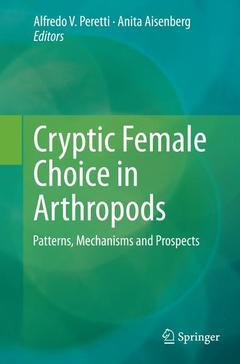Description
Cryptic Female Choice in Arthropods, 2015
Patterns, Mechanisms and Prospects
Coordinators: Peretti Alfredo V., Aisenberg Anita
Language: English
Subjects for Cryptic Female Choice in Arthropods:
Publication date: 10-2016
Support: Print on demand
Publication date: 06-2015
509 p. · 15.5x23.5 cm · Hardback
Description
/li>Contents
/li>Biography
/li>Comment
/li>
This timely book revisits cryptic female choice in arthropods, gathering detailed contributions from around the world to address key behavioral, ecological and evolutionary questions. The reader will find a critical summary of major breakthroughs in taxon-oriented chapters that offer many new perspectives and cases to explore and in many cases unpublished data. Many groups of arthropods such as spiders, harvestmen, flies, moths, crickets, earwigs, beetles, eusocial insects, shrimp and crabs are discussed.
Sexual selection is currently the focus of numerous and controversial theoretical and experimental studies. Selection in mating and post-mating patterns can be shaped by several different mechanisms, including sperm competition, extreme sexual conflict and cryptic female choice. Discrimination among males during or after copulation is called cryptic female choice because it occurs after intromission, the event that was formerly used as the definitive criterion of male reproductive success and is therefore usually difficult to detect and confirm. Because it sequentially follows intra- and intersexual interactions that occur before copulation, cryptic female choice has the power to alter or negate precopulatory sexual selection. However, though female roles in biasing male paternity after copulation have been proposed for a number of species distributed in many animal groups, cryptic female choice continues to be often underestimated. Furthermore, in recent years the concept of sexual conflict has been frequently misused, linking sexual selection by female choice irrevocably and exclusively with sexually antagonistic co-evolution, without exploring other alternatives.
The book offers an essential source of information on how two fields, selective cooperation and individual sex interests, work together in the context of cryptic female choice in nature, using arthropods as model organisms. It is bound to spark valuable discussions among scientists working in evolutionary biology across the world, motivating new generations to unveil the astonishing secrets of sexual biology throughout the animal kingdom.
Alfredo Vicente Peretti is Principal Researcher of the Consejo Nacional deInvestigaciones Científicas y Técnicas de la Argentina, Instituto de Diversidad y Ecología Animal (CONICET -IDEA) and Associate Professor of the Departamento de Diversidad Biológica y Ecología, Facultad de Ciencias Exactas Físicas y Naturales, Universidad Nacional de Córdoba, Argentina. His research on arachnids started in 1991 and initially focused on reproductive behavior in scorpions. His main areas of research are sexual selection, communication and evolution of genitalia in arthropods.
Anita Aisenberg is Assistant Professor of the Laboratorio of Etología, Ecología y Evolución, of the Instituto de Investigaciones Biológicas Clemente Estable, Montevideo, Uruguay and she is member of the Sistema Nacional de Investigadores (ANII) and the Programa de Desarrollo de Ciencias Básicas (PEDECIBA), Uruguay. Since 2002 she has been working on spider behavior. Her main interests are related to sexual selection, reproductive behavior and evolution of sex roles.
Covers cryptic female choice in arthropods with contributions by international experts
Provides the current data and critically discusses the different situations in which cryptic female choice has been considered in arthropods
Helps to complete a niche in the scientific formation of pre- or postgraduate students and serves as valuable source for discussions among scientists working in the field of evolutionary biology
Includes supplementary material: sn.pub/extras




